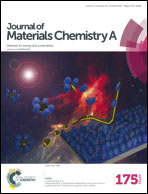The improvement of the shape memory function of poly(ε-caprolactone)/nano-crystalline cellulose nanocomposites via recrystallization under a high-pressure environment†
Abstract
The influence of extreme conditions such as high pressure and high temperature on shape memory function of polymers has received little attention. In this study, the shape memory properties of poly(ε-caprolactone) (PCL)-based nanocomposites with nano-crystalline cellulose (NCC) as fillers are investigated via recrystallization at a high temperature under a high-pressure environment. The sizes of spherulites of PCL, the degrees of crystallinity (Xc), and the melting temperature of the PCL–NCC nanocomposites were characterized by polarizing microscopy (POM), scanning electron microscopy (SEM), X-ray diffraction (XRD) and differential scanning calorimetry (DSC). The results exhibit that when the mass ratio of NCC was maintained constant, both the crystal properties and melting temperatures of the nanocomposites decreased with increasing pressure. Furthermore, the shape memory fixity ratios of the recrystallized nanocomposites remained more than 90% due to the fact that the chemical cross-linking structure and the recovery ratios kept increasing with the increase in pressure. The mechanism of the improvement of the shape memory function was further analyzed, and the result demonstrates that the pressure has a significant influence on the crystal properties of PCL polymers during their recrystallization; subsequently the shape recovery ratio is improved since more molecular chains participate in the shape recovery process.


 Please wait while we load your content...
Please wait while we load your content...